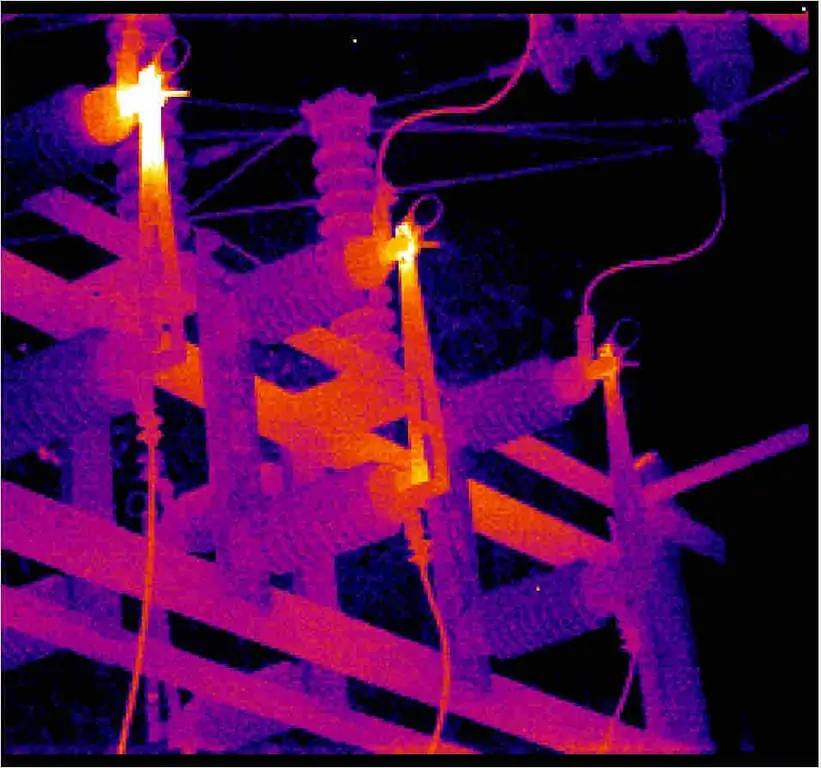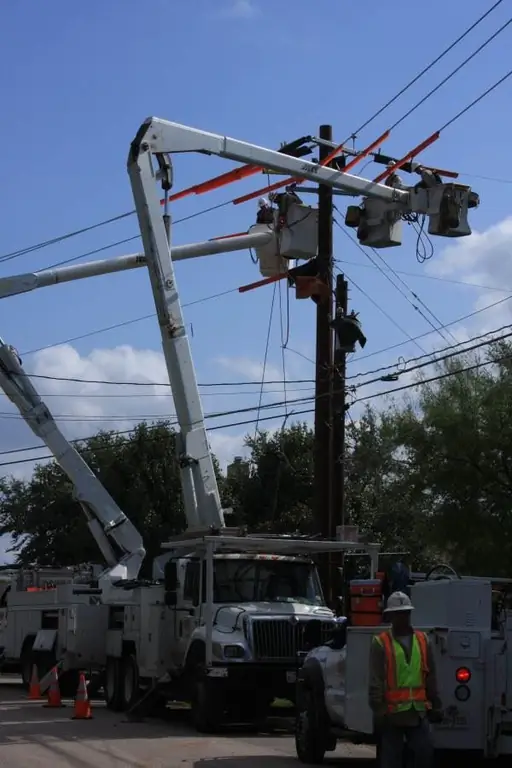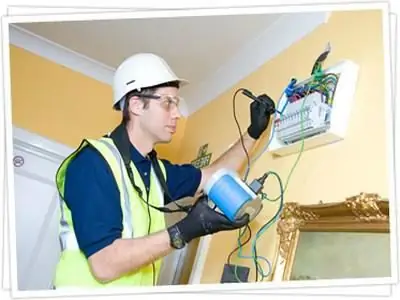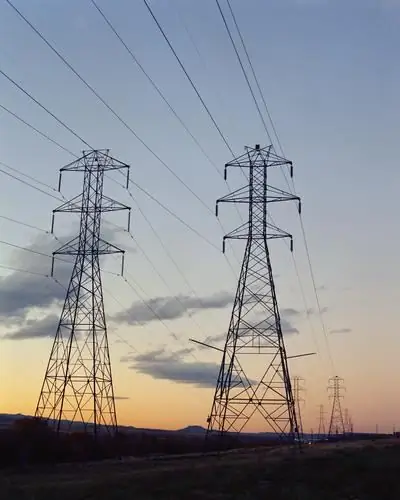2026 Author: Howard Calhoun | [email protected]. Last modified: 2025-01-24 13:10:37
Electrical engineers know what power plants and substations are, what they are for and how they work. They know how to calculate their power and all the necessary parameters, such as the number of turns, the wire cross section and the dimensions of the magnetic circuit. This is taught to students in technical universities and technical schools. People with a liberal arts background guess that structures, often standing alone in the form of windowless houses (graffiti lovers love to paint them), are needed to supply power to homes and businesses, and they should not be penetrated, frightening emblems in the form of skulls and lightning bolts speak eloquently about this attached to dangerous objects. Perhaps many do not need to know more, but information is never superfluous.

A bit of physics
Electricity is a commodity that you have to pay for, and it's a shame if it's wasted. And this, as in any production, is inevitable, the task is only to reduce unnecessary losses. Energy is equal to power multiplied by time, so in further reasoning we can operate with this concept, sohow time flows constantly, and it is impossible to turn it back, as the song says. Electric power, in a rough approximation, without taking into account reactive loads, is equal to the product of voltage and current. If we consider it in more detail, the cosine phi will enter the formula, which determines the ratio of consumed energy with its useful component, called active. But this important indicator is not directly related to the question of why a substation is needed. Electrical power thus depends on the two main contributors to Ohm's and Joule-Lenz's laws, voltage and current. Small current and high voltage can produce the same power as vice versa, high current and low voltage. It would seem, what's the difference? And it is, and very big.

Heat the air? Fire
So, if we use the active power formula, we get the following:
P=U x I, where:
U is voltage measured in Volts;
I is current measured in Amps;P is power measured in Watts or Volt-Amps.
But there is another formula that describes the already mentioned Joule-Lenz law, according to which the thermal power released during the passage of current is equal to the square of its magnitude, multiplied by the resistance of the conductor. To heat the air surrounding the power line is to waste energy. Theoretically, these losses can be reduced in two ways. The first of them involves a decrease in resistance, that is, a thickening of the wires. The larger the cross section, the lower the resistance, andvice versa. But I also don’t want to waste metal in vain, it’s expensive, copper after all. In addition, the double consumption of the conductor material will lead not only to an increase in cost, but also to weighting, which, in turn, will lead to an increase in the complexity of the installation of high-rise lines. And the supports will be required more powerful. And losses will only be halved.

Decision
To reduce the heating of wires during power transmission, it is necessary to reduce the amount of passing current. This is quite clear, because halving it will lead to a fourfold reduction in losses. What if ten times? The dependence is quadratic, which means that the losses will be a hundred times less! But the power must be "swing" the same, which is needed by the aggregate of consumers waiting for it at the other end of the power transmission line, sometimes hundreds of kilometers from the power plant. The conclusion suggests itself that it is necessary to increase the voltage by the same amount as the current is reduced. The transformer substation at the beginning of the transmission line is designed just for this. Wires come out of it under a very high voltage, measured in tens of kilovolts. Throughout the distance separating the thermal power plant, hydroelectric power station or nuclear power plant from the locality where it is addressed, energy travels with a small (relatively) current. The consumer, on the other hand, needs to receive power with the given standard parameters, which in our country correspond to 220 volts (or 380 V interphase). Now we need not a step-up, as at the input of a power line, but a step-down substation. Electrical energy is supplied to distribution devices so that lights are on in houses, andmachine rotors were spinning in factories.
What's in the booth?
From the above, it is clear that the most important part in a substation is a transformer, and usually a three-phase one. There may be several. For example, a three-phase transformer can be replaced by three single-phase ones. A larger number may be due to the high power consumption. The design of this device is different, but in any case, it has impressive dimensions. The more power is given to the consumer, the more serious the structure looks. The device of an electrical substation, however, is more complex, and includes more than just a transformer. There is also equipment designed for switching and protecting an expensive unit, and most often for its cooling. The electrical part of stations and substations also contains switchboards equipped with control and measuring equipment.

Transformer
The main task of this structure is to bring energy to the consumer. Before sending, the voltage must be increased, and after receiving it, lowered to the standard level.
With all the fact that the circuit of an electrical substation includes many elements, the main one is still a transformer. There is no fundamental difference between the device of this product in a conventional power supply of a household appliance and high-power industrial designs. The transformer consists of windings (primary and secondary) and a magnetic circuit made of a ferromagnet, that is, a material (metal) that amplifies the magnetic field. Calculationof this device is quite a standard educational task for a student of a technical university. The main difference between the substation transformer and its less powerful counterparts, which is conspicuous, in addition to size, is the presence of a cooling system, which is a set of oil pipelines encircling the heated windings. Designing electrical substations, however, is not an easy task, as many factors must be taken into account, ranging from climatic conditions to the nature of the load.

Tractive power
It's not just homes and businesses that consume electricity. Everything is clear here, you need to apply 220 volts AC relative to the neutral bus or 380 V between phases at a frequency of 50 Hertz. But there is also urban electric transport. Trams and trolleybuses require a voltage not alternating, but constant. And different. There should be 750 Volts on the contact wire of the tram (relative to the ground, that is, the rails), and the trolleybus needs zero on one conductor and 600 Volts DC on the other, rubber wheel protectors are insulators. This means that a separate very powerful substation is needed. Electrical energy is converted on it, that is, it is rectified. Its power is very large, the current in the circuit is measured in thousands of amperes. Such a device is called a draft device.

Substation protection
Both the transformer and the powerful rectifier (in the case of traction power supplies) are expensive. If there isan emergency situation, namely a short circuit, a current will appear in the secondary winding circuit (and, consequently, the primary one). This means that the cross section of the conductors is not calculated. The electrical transformer substation will begin to heat up due to resistive heat generation. If such a scenario is not foreseen, then as a result of a short circuit in any of the peripheral lines, the winding wire will melt or burn. To prevent this from happening, various methods are used. These are differential, gas and overcurrent protections.
Differential compares the current values in the circuit and the secondary winding. Gas protection is activated when combustion products of insulation, oil, etc. appear in the air. Current protection turns off the transformer when the current exceeds the maximum set value.
The transformer substation should automatically shut down also in the event of a lightning strike.
Types of substations
They are different in power, purpose and device. Those of them that serve only to increase or decrease the voltage are called transformer. If a change in other parameters is also required (rectification or frequency stabilization), then the substation is called a transforming substation.
According to their architectural design, substations can be attached, built-in (adjacent to the main facility), intrashop (located inside the production facility) or represent a separate auxiliary building. In some cases, when high power is not required (when organizing power supplysmall settlements), the mast structure of substations is used. Sometimes power transmission towers are used to place the transformer, on which all the necessary equipment is mounted (fuses, arresters, disconnectors, etc.).
Electrical networks and substations are classified by voltage (up to 1000 kV or more, that is, high voltage) and power (for example, from 150 VA to 16 thousand kVA).
According to the schematic sign of the external connection, substations are divided into nodal, dead-end, through and branch.
Inside cell
The space inside the substation, in which the transformers, busbars and equipment that ensures the operation of the entire device, is called the chamber. It can be fenced or closed. The difference between the ways of alienating it from the surrounding space is small. The closed chamber is a completely isolated room, and the fenced one is located behind non-solid (mesh or lattice) walls. They are made, as a rule, by industrial enterprises according to standard designs. Maintenance of power supply systems is carried out by trained personnel with permission and the necessary qualifications, confirmed by an official document on permission to work on high-voltage lines. Operational supervision of the operation of the substation is carried out by an electrician or power engineer on duty, located near the main switchboard, which may be located remotely from the substation.
Distribution
There is another important function that the power substation performs. Electrical energy is distributed betweenconsumers according to their standards, and in addition, the load of the three phases should be as uniform as possible. In order for this task to be successfully solved, there are distribution devices. The switchgear operates at the same voltage and contains devices that perform switching and protect lines from overload. The switchgear is connected to the transformer by fuses and breakers (single-pole, one for each phase). Distribution devices according to the location are divided into open (located in the open air) and closed (located indoors).

Safety
All work performed in the electrical substation is classified as especially risky, therefore, it requires emergency measures to ensure labor safety. Basically, repairs and maintenance are carried out with a complete or partial blackout. After the voltage is disconnected (electricians say "removed"), provided that all necessary tolerances are in place, the current-carrying bars are grounded to prevent accidental activation. Warning signs “People are working” and “Do not turn on!” Are also intended for this. Personnel serving high-voltage substations are systematically trained, and the skills and acquired knowledge are periodically monitored. Tolerance No. 4 gives the right to perform work on electrical installations over 1 kV.
Recommended:
Thermal imaging control of electrical equipment: concept, principle of operation, types and classification of thermal imagers, features of application and verification

Thermal imaging control of electrical equipment is an effective way to identify defects in power equipment that are detected without shutting down the electrical installation. In places of poor contact, the temperature rises, which is the basis of the methodology
Electricity distribution: substations, necessary equipment, distribution conditions, application, accounting and control rules

Everyone knows that electrical energy is supplied to the place of its consumption from a direct source. However, such sources can be located at a great distance from the consumer. Because of this, the distribution of electricity and its delivery is a rather complicated process
Work permit for work in electrical installations. Rules for work in electrical installations. Work permit

From August 2014, Law No. 328n comes into force. In accordance with it, a new edition of the "Rules on labor protection during the operation of electrical installations" is being introduced
Mast transformer substation: principle of operation and purpose

The article is devoted to mast transformer substations. The device, principle of operation, types and purpose of such equipment are considered
Maintenance of transformer substations: frequency and requirements

Transformer substations, together with distribution devices, form the necessary voltage regulation nodes in electricity delivery networks. These are multicomponent systems, on which the stability of the supply of industrial, public and private buildings, communications and equipment for various purposes directly depends. Timely maintenance of the transformer substation and related working components allows maintaining the proper functioning of the network

